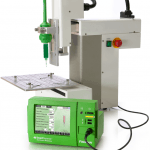 Originally when discussing the dispensing of cyanoacrylates, I was going to ask; what do a catheter, a golf club and a cell phone have in common. However, now I need to add one more “item”. Yesterday I heard on ESPN about the “instant cure” of wounds by hockey players from the Rangers and Capitals. There must have been a lot of blood because Tuesday’s playoff game had 3 overtimes. Now hockey players are part of my list.
Originally when discussing the dispensing of cyanoacrylates, I was going to ask; what do a catheter, a golf club and a cell phone have in common. However, now I need to add one more “item”. Yesterday I heard on ESPN about the “instant cure” of wounds by hockey players from the Rangers and Capitals. There must have been a lot of blood because Tuesday’s playoff game had 3 overtimes. Now hockey players are part of my list.
So the question is, what do catheters, golf clubs, cell phones and hockey players all have in common? The answer is, that they are all put together by fluid dispensing of super glues, otherwise known as cyanoacrylates. Yes, it is true! Like catheters, golf clubs and cell phones, these hockey players, and apparently many others before them, use cyanoacrylates to close wounds. They use cyanoacrylates because as soon as cyanoacrylates are exposed to the air, cyanoacrylates cure instantly and they can go right back into the game.
However, I have to say that knowing what I know about the chemicals in it, I can’t imagine putting cyanoacrylates on my skin, let alone cyanoacrylates in my skin. For the brave, watch this video and you will see one of these warriors being patched up. Wow, after a bit of a web search, seems like lots of pro atheletes skip the doctor and have been dispensing cyanoacrylates as a wound sealer for years.
Medical device and other manufacturers have been attracted to cyanoacrylate, also known as “CA” or “super glue,” because of its very short cure time and great bond strength. Cyanoacrylates come in thin fluids or gels, this adhesive reacts with moisture ions on the surface of the conjoining substrates, thus creating the bond. The bond strength is greatly impacted by the application of the adhesive to the substrates. Too much cyanoacrylate may keep the bond from curing properly while too little adhesive may cause the bond to fail.
The Fishman® AirFree® SmartDispenser® is a positive displacement system that removes unreliable moisture-filled air from the dispensing process. It is used for most cyanoacrylate assembly applications where cyanoacrylates are the fluid of choice…..except in the NHL.
In fact, those manufacturers that have tried to dispense cyanoacrylate with pneumatics often come to us because their employees complain about how the air in and around the pneumatic fluid dispenser system causes it to cure on their hands!
